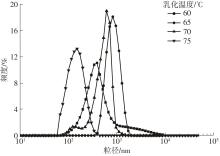华南理工大学学报(自然科学版) ›› 2025, Vol. 53 ›› Issue (1): 101-107.doi: 10.12141/j.issn.1000-565X.240128
非离子型水性环氧乳化剂的合成及乳化效果
李文波, 易蝶
- 华南理工大学 材料科学与工程学院,广东 广州 510640
Synthesis and Emulsifying Effect of Nonionic Waterborne Epoxy Resin Emulsifiers
LI Wenbo YI Die
- School of Materials Science & Engineering,South China University of Technology,Guangzhou 510640,Guangdong,China
摘要:
为提高乳化剂与环氧树脂的相容性,以不同相对分子质量的聚乙二醇(PEG6000、PEG4000、PEG2000)、甲基六氢邻苯二甲酸酐(MHHPA)和环氧树脂(E44)为原料,采用两步法合成了一系列A-B-A型(A为环氧链段,B为亲水链段)结构的非离子型水性环氧乳化剂。采用傅里叶变换红外光谱仪对乳化剂结构进行表征,并通过红外光谱分析与酸值滴定确定了该乳化剂的最佳合成工艺:PEG和MHHPA按照物质的量之比为1∶2.1进行酯化反应,温度为110 ℃,时间为3 h;然后加入与MHHPA等物质的量的E44,在催化剂四丁基溴化铵(TBAB,环氧树脂用量的1%)的作用下进行环氧开环反应,温度为110 ℃,时间为3 h。将合成的乳化剂应用于环氧树脂E44制备出水性环氧乳液,研究了乳液稳定性的多种影响因素,包括PEG相对分子质量、乳化剂含量、乳化温度和搅拌速度。综合考虑乳液稳定性、粒径及其分布等因素,发现采用PEG6000合成的乳化剂具有更好的乳化效果,其HLB值为16.5、浊点为90 ℃,优于使用PEG4000与PEG2000合成的乳化剂。当乳液固含量约为45%时,在20%的乳化剂含量下,以75 ℃的乳化温度、2 000 r/min的搅拌速度进行乳化处理,能够得到平均粒径较小且分布较窄的水性环氧乳液,其具有良好的乳液稳定性。
中图分类号:

















